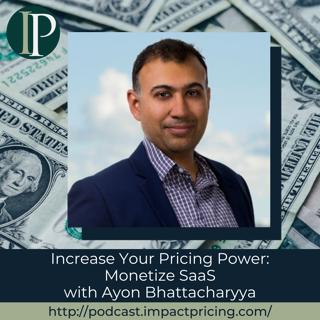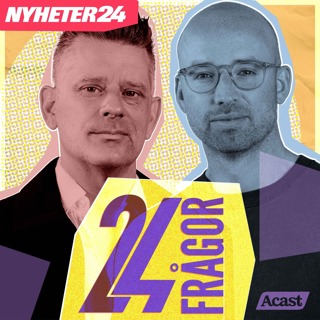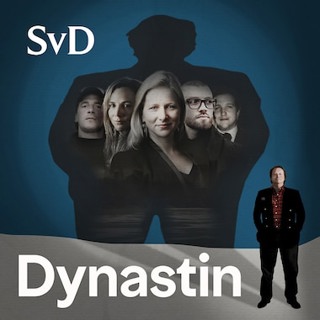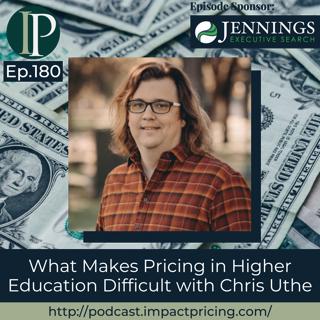
What Makes Pricing in Higher Education Difficult with Chris Uthe
Christopher Uthe is the Director of Product Management at Ocelot, where he champions scalable day-to-day organizational changes to transform it to a product-driven company. He's been working in the education market since 2006, both for an educational institution and for companies that sell education. Chris started his first business at the age of 16. In this episode, Chris explains how pricing works in institutions of higher education as he discusses the factors that make pricing difficult in that field. Why you have to check out today’s podcast: Find out how to find value if you can’t get a good and apt pricing metric Understand how pricing in higher educational institutions work, as well as the thing that makes it difficult Discover why higher education should be more focused on B2C pricing than on B2B “It's so hard to bundle and discount correctly, that most of the time, that's not being done right.” – Chris Uthe Topics Covered: 01:28 – The story behind Chris’ interest in pricing 02:15 – Pricing and purchasing decisions in higher education 04:37 – What institutions of higher education value: The thing that makes pricing in higher education difficult 08:18 – U.S. News and World Report as a metric: The intrinsic value of one’s degree and/or university 11:15 – In B2C vs. in B2B pricing: Where should institutions of higher education be? 14:17 – Talking about RFPs: How it leads us to lose sight of the possibility of a better and smarter solution 19:42 – Chris’ pricing advice for the listeners 21:45 – Connect with Chris Uthe Key Takeaways: “It's so difficult to come at these purchasing decisions, saying, ‘Okay, we have to do only what's best for the student here,’ because you've got so many competing priorities that are sort of odd for the market.” – Chris Uthe “Some would tell you that they don't care. There are a sad few that would tell you they might care a little bit about profit because they do have to pay the bills, still. Not all of them are living on generous endowments, unfortunately, or fortunately, depending on how you look at it. They care about, hopefully, students’ success at the end of the day. They want to talk to you about placement rate. They want to talk to you about probably job acceptance rate. They want to talk to you about average salary coming out of school.” – Chris Uthe “Some of the value – the unspoken value – of your degree or just going to an institution comes from all the doors that it opens for having it on your resume.” – Chris Uthe “It almost always starts with a very altruistic need, which I think is amazing in higher ed, because our students aren't getting the help they need at the right time, for instance, or these students aren't able to log into the learning management system and do something meaningful at the right time or they don't know how to do it, they can't get it done. It starts very altruistic, which is one of my favorite parts of higher education, because it does usually come back to making the student more successful.” – Chris Uthe People / Resources Mentioned: Ocelot: https://www.ocelotbot.com/ CARES Act: https://www.congress.gov/bill/116th-congress/house-bill/748 Connect with Chris Uthe: LinkedIn:https://www.linkedin.com/in/chrisuthe/ Email: uthe@ocelotbot.com Connect with Mark Stiving: LinkedIn: https://www.linkedin.com/in/stiving/ Email: mark@impactpricing.com
4 Juli 202222min

Blogcast #61: Are iPhone Users Not Price Sensitive?
This is an Impact Pricing Blog published on May 25, 2022, turned into an audio podcast so you can listen on the go. Read Full Article Here: https://impactpricing.com/blog/are-iphone-users-not-price-sensitive/ If you have any feedback, definitely send it. You can reach us at mark@impactpricing.com. Now, go make an impact. Connect with Mark Stiving: Email: mark@impactpricing.com LinkedIn: https://www.linkedin.com/in/stiving/
1 Juli 20223min
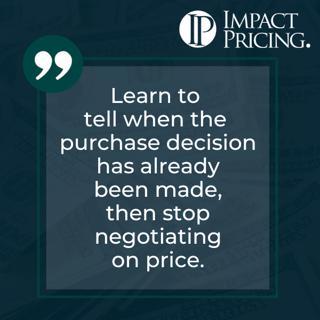
Memecast #64: Stop Negotiating
Oftentimes, salespeople are selling to a committee of people who have to make a big decision. Once they've made the decision, they typically say, hey, we want to go with this vendor, and then they submit it to purchasing or procurement. At that point in time, procurement pretends to be price sensitive, pretends that there's multiple different competitors involved. But if we can recognize that we've already been chosen, then we don't have to compete hard on price. This happens often, especially if we're going to be selling to a committee who has to make a decision. We hope you enjoyed this memecast. This impactful insight came from the book, Selling Value, which I wrote to help salespeople win more deals at higher prices. If you have any questions or feedback, please email me mark@impactpricing.com. Now go make an impact. Connect with Mark Stiving: Email: mark@impactpricing.com LinkedIn: https://www.linkedin.com/in/stiving/
29 Juni 20221min
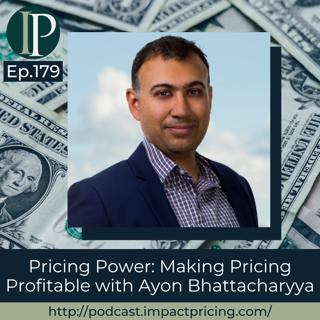
Pricing Power: Making Pricing Profitable with Ayon Bhattacharyya
Ayon Bhattacharyya is the Founder of Biz Growth Spurt, a consulting firm based out of New Zealand. He has experienced pricing in half a dozen companies, and he's a passionate animal welfare advocate. In this episode, Ayon discusses pricing power as he enumerates its four different levels while talking about value-based pricing. Why you have to check out today’s podcast: Understand how pricing power relates to price elasticity Find out what Ayon’s four different levels of pricing power are all about Discover how Mark’s will I? which one? concept relates to these levels “Think about your pricing power, and think about how – whether it's sort of competitive advantage, perceived value, all of those things – what can you do differently to improve your pricing power today.” – Ayon Bhattacharyya Topics Covered: 01:18 – How Ayon got into pricing 02:33 – Defining value-based pricing and relating it to airline pricing 05:57 – Pricing power vs. price elasticity 09:50 – Ayon’s four different levels of pricing power 13:33 – Describing the levels: (1) Cost chaser 15:04 – Describing the levels: (2) Market pricer 15:46 – Describing the levels: (3) Value conqueror 18:16 – Doing behavioral economics at a cost chaser level 19:09 – Applying Mark’s “will I? which one?” concept to Ayon’s levels of pricing power 22:19 – Talking about value-based and fixed pricing 25:26 – Ayon’s piece of pricing advice for the listeners Key Takeaways: “Pricing power is essentially your ability to charge a higher price without losing customers. Another way to say that is a company's ability to get the price it deserves for the value it delivers.” – Ayon Bhattacharyya “A maturity suggests that you need to get there over a period of time; you grow into it. It can't be something that you just start out with that, at level three. But that's not what I'm trying to say here. You can actually start out and you can be an early-staged business and you can start out as a value conqueror. You don't need to progress from level one to get to level three. You can start at level three.” – Ayon Bhattacharyya “There are some businesses that can just start at a higher level, but I think generally, it is a journey. I think of pricing strategy as a journey, not just an outcome.” – Ayon Bhattacharyya People / Resources Mentioned: Biz Growth Spurt: https://bizgrowthspurt.com/ Stephan Liozu and his book: The Pricing Journey Connect with Ayon Bhattacharyya: Website: https://bizgrowthspurt.com/ LinkedIn: https://nz.linkedin.com/in/ayonb Email: b@bizgrowthspurt.com Connect with Mark Stiving: LinkedIn: https://www.linkedin.com/in/stiving/ Email: mark@impactpricing.com
27 Juni 202227min

Blogcast #60: How Much Does a Buyer Values Your Product?
This is an Impact Pricing Blog published on May 18, 2022, turned into an audio podcast so you can listen on the go. Read Full Article Here: https://impactpricing.com/blog/how-much-does-a-buyer-value-your-product/ If you have any feedback, definitely send it. You can reach us at mark@impactpricing.com. Now, go make an impact. Connect with Mark Stiving: Email: mark@impactpricing.com LinkedIn: https://www.linkedin.com/in/stiving/
24 Juni 20222min
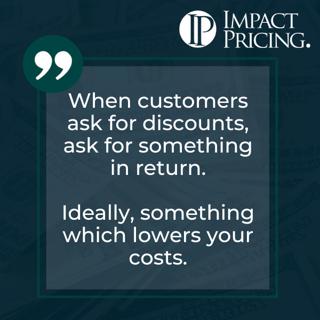
Memecast #63: Gives and Gets
You probably know that when we're negotiating, we do gifts and gets. We don't give anything unless we get something in return. Purchasing people are always asking us for discounts and sometimes we have to give in. We give a discount to a client or a customer. What should we get in return? Well, we should be thinking first about the things that are hard costs for us to serve our clients. For example, maybe there's a shipping cost. Maybe it's a warranty cost. But there are things that are truly that cost us money and if we can get those as clawbacks, as our gets when we give something, then we're actually giving up a lower margin. Many people call this pocket price. So, pocket price is, what's the price after I've looked at what are my costs to serve that individual customer. We hope you enjoyed this memecast. This impactful insight came from the book, Selling Value, which I wrote to help salespeople win more deals at higher prices. If you have any questions or feedback, please email me mark@impactpricing.com. Now, go make an impact. Connect with Mark Stiving: Email: mark@impactpricing.com LinkedIn: https://www.linkedin.com/in/stiving/
22 Juni 20221min
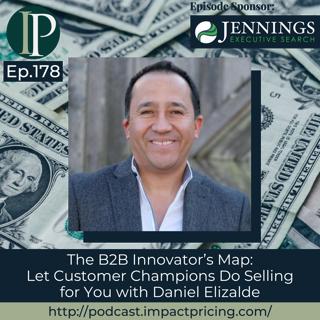
The B2B Innovator’s Map: Let Customer Champions Do Selling for You with Daniel Elizalde
Daniel Elizalde was an IoT Product Manager Instructor at Stanford University. He used to work as the VP Head of IoT at Ericsson, but he has now narrowed his focus from IoT to climate tech firms. Daniel now helps climate tech product teams accelerate their product’s time to the market. In this episode, Daniel talks about his book, The B2B Innovator’s Map, as he explains why delivering value to your champion is a huge game-changer in the business world. Why you have to check out today’s podcast: Discover what the book The B2B Innovator’s Map is all about; Understand why you, as a vendor, should understand what value means both to your company and to your customers; and Find out why you should look for champions and not for buyers, especially when you’re still starting in doing business “When you are testing a potential solution, pricing has to be one of those things that you have to prototype. You have to prototype the packaging and the offering and how you actually present it to the customer.” – Daniel Elizalde Topics Covered: 01:55 – A Narrower Focus: Daniel shares the backstory on how he’s decided to shift his focus from IoT to climate tech firms 04:11 – Daniel talks about the benefits of running his own consulting practice 06:18 – Helping other people, still, in the space of IoT 07:41 – Why Daniel wrote his book, The B2B Innovator’s Map 09:46 – The difference between B2B and B2C in terms of the way people do innovation + the content of Daniel’s book 14:35 – Relating Mark’s Selling Value book to Daniel’s B2B Innovator’s Map 18:51 – Understanding the strongest problems that your customers have as one of the main points in the book 21:50 – Looking for a champion, not a buyer persona + the goal of innovation 28:36 – Daniel’s piece of pricing advice for the listeners Key Takeaways: “For an actual advisory project where I'm involved at the strategic level, I'm going to give priority to the climate tech companies, but that doesn't mean that there are no other avenues where people can get access to some of my experience.” – Daniel Elizalde “In my experience, a lot of the B2B products fail because they don't deliver value to their customers, like, customers don't see the benefit, they don't want to buy it, so they've failed. Value has to be delivered throughout, and so, therefore, value plays an immense part throughout the journey.” – Daniel Elizalde “Granted, as a vendor, your own solution is not going to be the fix for the whole problem, and you're part of the whole puzzle. But as a vendor, you have to understand what are those pains, what are those problems that your customers are having, because that's where the opportunity to deliver value lies.” – Daniel Elizalde “The value needs to be big for a big problem so that you can get a solution in the door.” – Daniel Elizalde “It's not about the users at this point. It's about delivering value to the champion because ultimately, that's the person that's going to open the door for you.” – Daniel Elizalde People / Resources Mentioned: The B2B Innovator’s Map: https://danielelizalde.com/b2b-innovators-map/ Ericsson: https://www.ericsson.com/ Selling Value: https://www.amazon.com/Selling-Value-Deals-Higher-Prices/dp/1737655217/ Crossing the Chasm: https://www.amazon.com/Crossing-Chasm-3rd-Disruptive-Mainstream/dp/0062292986 Connect with Daniel Elizalde: LinkedIn:https://www.linkedin.com/in/danielelizalde/ Website:https://danielelizalde.com/ Connect with Mark Stiving: LinkedIn: https://www.linkedin.com/in/stiving/ Email: mark@impactpricing.com
20 Juni 202231min

Blogcast #59: Data and/or Value
This is an Impact Pricing Blog published on May 11, 2022, turned into an audio podcast so you can listen on the go. Read Full Article Here: https://impactpricing.com/blog/data-and-or-value/ If you have any feedback, definitely send it. You can reach us at mark@impactpricing.com. Now, go make an impact. Connect with Mark Stiving: Email: mark@impactpricing.com LinkedIn: https://www.linkedin.com/in/stiving/
17 Juni 20223min
